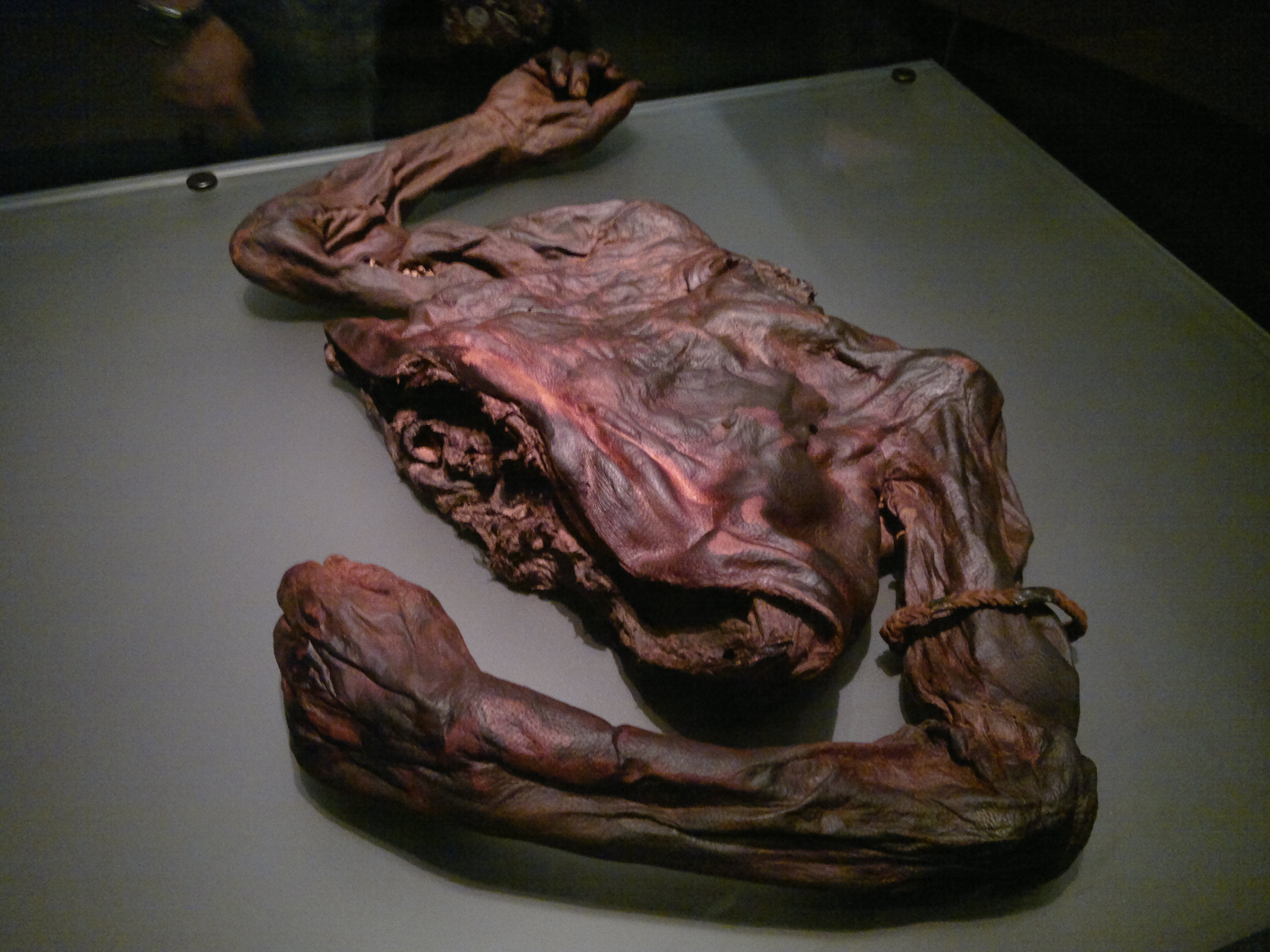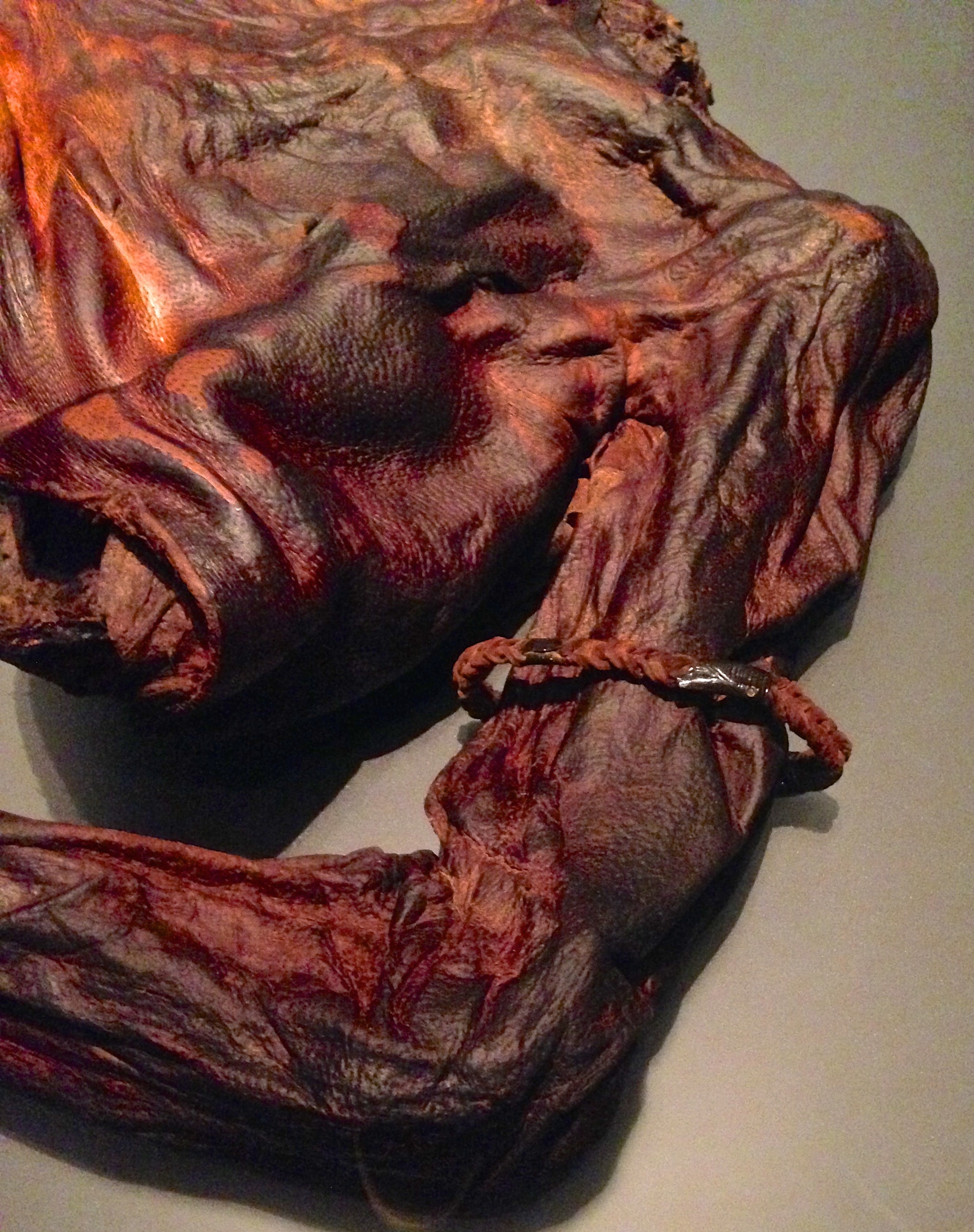Old Croghan Man on:
[Wikipedia]
[Google]
[Amazon]

 Old Croghan Man (''Seanfhear Chruacháin'' in
Old Croghan Man (''Seanfhear Chruacháin'' in

 Old Croghan Man (''Seanfhear Chruacháin'' in
Old Croghan Man (''Seanfhear Chruacháin'' in Irish
Irish may refer to:
Common meanings
* Someone or something of, from, or related to:
** Ireland, an island situated off the north-western coast of continental Europe
***Éire, Irish language name for the isle
** Northern Ireland, a constituent unit ...
) is a well-preserved Irish Iron Age
The Iron Age is the final epoch of the three-age division of the prehistory and protohistory of humanity. It was preceded by the Stone Age ( Paleolithic, Mesolithic, Neolithic) and the Bronze Age ( Chalcolithic). The concept has been mostl ...
bog body found in June 2003. The remains are named after Croghan Hill
Croghan Hill ( or ''Brí Éile'') is a hill with a height of in County Offaly, Ireland. The remains of an extinct volcano, it rises from the Bog of Allen and dominates the surrounding plains. Historically known as ''Brí Éile'', it is menti ...
, north of Daingean
Daingean (; or ), formerly Philipstown, named after King Philip II of Spain, is a small town in east County Offaly, Ireland. It is situated midway between the towns of Tullamore and Edenderry on the R402 regional road. The town of Daingean ...
, County Offaly, near where the body was found. The find is on display in the National Museum of Ireland in Dublin
Dublin (; , or ) is the capital and largest city of Ireland. On a bay at the mouth of the River Liffey, it is in the province of Leinster, bordered on the south by the Dublin Mountains, a part of the Wicklow Mountains range. At the 2016 c ...
.
Old Croghan Man was found three months after a similar find, dubbed Clonycavan Man
Clonycavan Man is the name given to a well-preserved Iron Age bog body found in Clonycavan, Ballivor, County Meath, Ireland in March 2003. The body shows signs of having been murdered. Theories around the meanings and manner of his death vary. ...
, in County Meath
County Meath (; gle, Contae na Mí or simply ) is a county in the Eastern and Midland Region of Ireland, within the province of Leinster. It is bordered by Dublin to the southeast, Louth to the northeast, Kildare to the south, Offaly to the ...
.
Life
The man is calculated (based on his arm span) to have stood approximately between 5 ft 11.5 in and tall, which is considered to be exceptionally tall for the period when he lived. The man's apparently manicured nails led to speculation that he was not someone who engaged in manual labour, and possibly therefore of high status. His last meal (analysed from the contents in his stomach) was believed to have beenwheat
Wheat is a grass widely cultivated for its seed, a cereal grain that is a worldwide staple food. The many species of wheat together make up the genus ''Triticum'' ; the most widely grown is common wheat (''T. aestivum''). The archaeologi ...
and buttermilk
Buttermilk is a fermented dairy drink. Traditionally, it was the liquid left behind after churning butter out of cultured cream. As most modern butter in western countries is not made with cultured cream but uncultured sweet cream, most m ...
. However, he was shown to have had a meat rich diet for at least the 4 months prior to his death. Scars on his lungs
The lungs are the primary organs of the respiratory system in humans and most other animals, including some snails and a small number of fish. In mammals and most other vertebrates, two lungs are located near the backbone on either side ...
suggest he may have suffered from pleurisy
Pleurisy, also known as pleuritis, is inflammation of the membranes that surround the lungs and line the chest cavity ( pleurae). This can result in a sharp chest pain while breathing. Occasionally the pain may be a constant dull ache. Other sy ...
.
Death
The man was buried at a bog (likely once a lake) at the foot of an ancient hill that was used for kingship ceremonies. A 2014 documentary suggested that he was a king or prince who was sacrificed by druids due to poor weather or harvests. These ancient tribes may have believed that this was caused by the failure of the king and he was responsible. Old Croghan Man is believed to have died between 362 BC and 175 BC, making the body over 2,000 years old. Evidence indicates that the man was in his early twenties when he was killed. He was naked except for a plaitedleather
Leather is a strong, flexible and durable material obtained from the tanning, or chemical treatment, of animal skins and hides to prevent decay. The most common leathers come from cattle, sheep, goats, equine animals, buffalo, pigs and hog ...
band around his left arm. This likely indicated high status. The man is believed to have died from a stab wound to the chest. He was decapitated
Decapitation or beheading is the total separation of the head from the body. Such an injury is invariably fatal to humans and most other animals, since it deprives the brain of oxygenated blood, while all other organs are deprived of the i ...
and had his body cut in half. He also has an injury to one arm, possible evidence that he tried to defend himself. A similar wound has been seen on the Cashel Man, who was found in 2011, also in Ireland.
The body was found to have deep cuts under each nipple. Several theories have been suggested to explain this, including that the damage was caused (after death) by conditions in the bog, that the cuts were indicative of torture while the man was alive, or that the nipples were deliberately mutilated (either before or after death) for symbolic purposes. The latter theory, put forward by Eamonn Kelly of the National Museum of Ireland, suggests that the mutilation was a symbolic gesture to mark the man as a rejected ruler. Other theories suggest that Old Croghan Man and other bog bodies were sacrifices to gods of fertility or harvest, and killed and buried to ensure good yields of cereals and buttermilk
Buttermilk is a fermented dairy drink. Traditionally, it was the liquid left behind after churning butter out of cultured cream. As most modern butter in western countries is not made with cultured cream but uncultured sweet cream, most m ...
.
Arm-ring
The arm-ring found with the body was made from waterlogged leather, strands of fibres and four bronze mounts. According to Louise Mumford of the National Museum, the leather ring was made with two strands of leather joined together through numerous small slits. The ring was initially removed from the body and wet cleaned to remove elements like peat from the leather. To prevent further decay of the waterlogged leather work and mould growth the arm-ring was stored in a 20% solution of glycerol and de-ionised water for two weeks in a process called consolidation. After drying and further chemical cleaning and treatment to prevent corrosion, the arm-ring was returned to the body for display.Related mythology
Croghan Hill
Croghan Hill ( or ''Brí Éile'') is a hill with a height of in County Offaly, Ireland. The remains of an extinct volcano, it rises from the Bog of Allen and dominates the surrounding plains. Historically known as ''Brí Éile'', it is menti ...
is known as Bri Eile in Irish myth. In "The Boyhood Deeds of Fionn
''The Boyhood Deeds of Fionn'' ( ga, Macgnímartha Finn) is a medieval Irish narrative belonging to the Fenian Cycle of Irish mythology. As its title implies, it recounts the boyhood exploits of Fionn mac Cumhaill, the cycle's central figure.
O ...
", we are told "At that time there was a very beautiful maiden in Bri Ele, that is to say, in the fairy-knoll of Bri Ele, and the name of that maiden was Ele. The men of Ireland were at feud about that maiden. One man after another went to woo her. Every year on Samain
Samhain ( , , , ; gv, Sauin ) is a Gaelic festival on 1 NovemberÓ hÓgáin, Dáithí. ''Myth Legend and Romance: An Encyclopaedia of the Irish Folk Tradition''. Prentice Hall Press, 1991. p. 402. Quote: "The basic Irish division of the year ...
the wooing used to take place; for the fairy-mounds of Ireland were always open about Samain; for on Samain nothing could ever be hidden in the fairy-mounds. To each man that went to woo her this used to happen: one of his people was slain. This was done to mark the occasion, nor was it ever found out who did it."
See also
*Clonycavan Man
Clonycavan Man is the name given to a well-preserved Iron Age bog body found in Clonycavan, Ballivor, County Meath, Ireland in March 2003. The body shows signs of having been murdered. Theories around the meanings and manner of his death vary. ...
* Cashel Man
* Bog body
References
{{Bog body 2003 archaeological discoveries Archaeological sites in County Offaly Bog bodies Bogs of Ireland Celtic archaeological sites Collection of the National Museum of Ireland People from County Offaly Prehistoric Ireland Prehistoric burials in Ireland Year of birth unknown Year of death uncertain